what are the ways to use copyrighted materials lawfully
Lesson 3: Copyright and Fair Apply
/en/useinformationcorrectly/avoiding-plagiarism/content/
Copyright and fair use
In our Avoiding Plagiarism lesson, we gave you lot tips for citing, quoting, and incorporating diverse sources into your writing projects. Nevertheless, depending on what types of sources yous utilize, you may also accept to consider copyright and fair utilize laws. For example, if you want to apply someone else's photograph or song in one of your own projects, you lot'll need to brand certain you take the legal right to do then.
In this tutorial, you'll learn about the copyright protections that apply to work posted online, including images, text, videos, and more. You'll likewise larn nigh the rules that determine which of these resources you can employ, and how you can utilise them.
Sentinel the video beneath to larn about copyright, public domain, and fair employ.
The laws discussed in this tutorial are U.s.a. laws. No lawyer was involved in preparing this tutorial. We are not legal experts, and this tutorial should not exist taken as legal advice.
What is copyright?
Copyright is the legal concept that works—art, writing, images, music, and more than—vest to the people who create them. Co-ordinate to copyright law, any original content yous create and record in a lasting form is your own intellectual property. This means other people tin can't legally copy your piece of work and pretend it's their own. They can't make coin from the things y'all create either.
You can still cite and refer to other sources (including copyrighted materials) in your piece of work. Only to use, copy, or change a copyrighted piece of work, yous need permission from the person who holds the copyright. This permission is called a license.
Although anybody has the right to require that others respect their copyright and ask permission to utilise their work, some people and organizations choose to license their content more than freely. They practice this by giving their piece of work a Artistic Eatables license, or by placing their work in the public domain.
Review the infographic to get an overview of the differences among traditional copyright, Creative Commons, and public domain.
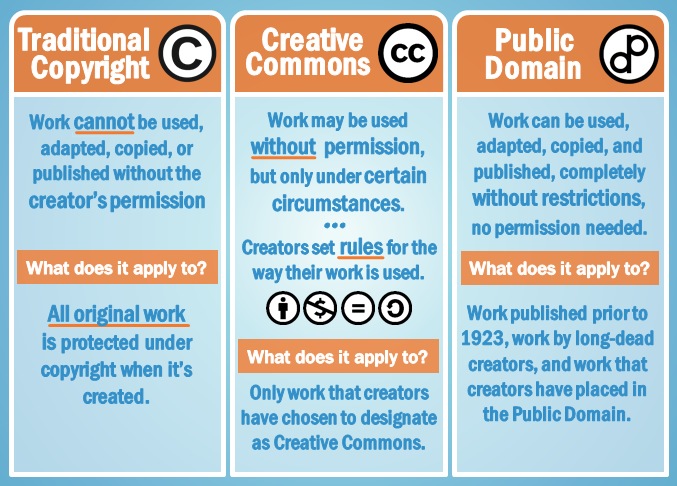
Obtaining free content
If everything on the Internet belongs to someone, how do you obtain images, music, and other materials y'all tin use in your projects for free? The answer is through public domain and Artistic Commons-licensed content. To acquire more, review the tips below.
Tip #i: Use public domain content
There are no restrictions on using works that are in the public domain, which means you lot tin use them nonetheless y'all desire—short of claiming that yous created them yourself. Unfortunately, it's not e'er like shooting fish in a barrel to tell whether or not something is in the public domain. There may exist some cases when you lot know for certain that a work is public domain (for instance, if you discover a photo or text yous are sure was published before 1923), only for the well-nigh part the best manner to find public domain content is to search for it specifically.
For assistance finding public domain content, visit these resources:
- Prelinger Archives
- U.South. Government Photos and Images
Tip #2: Use Artistic Commons content
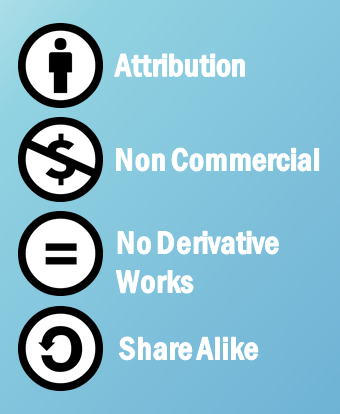 The symbols for Creative Commons licenses
The symbols for Creative Commons licenses
Although Creative Eatables content won't cost you any money to obtain, it's non totally free: To employ it, you must follow certain rules. People who choose to brand their content Creative Eatables tin choose one or more of these licenses to apply to their piece of work:
- Attribution: You must credit the creator in order to apply, copy, or share the content.
- Non-Commercial: You can't make a profit from the content.
- No Derivative Works: You can't alter the content.
- Share Akin: You can change the content, merely you have to let other people use your new piece of work with the same license every bit the original. You can't treat any Share Alike work that yous adapt as your own copyright, even if yous radically alter it.
For help finding Artistic Commons content, try these resources:
- Wikimedia Commons
- Flickr: Creative Commons
- Creative Commons Search
How to tell if content is Creative Commons
To tell if a piece of content is Creative Eatables, look for the Creative Commons symbol, besides as symbols that signal exactly which licenses use to it.

For instance, the symbols in the example below indicate that the photograph has three licenses: Attribution, Non Commercial, and No Derivative Works. This means y'all can utilise this photo if you credit the person who created it, don't make money from it, and don't change it.
 Creative Commons license information for a photograph
Creative Commons license information for a photograph
Finding content with Google
Google allows you to filter your search results to only show Creative Eatables and public domain works. When conducting an avant-garde search, you can cull which usage rights you want Google to search for. For example, if you're searching for an image to employ in your blog, you tin can change the usage rights to free to use or share.
 Filtering a Google search past usage rights
Filtering a Google search past usage rights
For more data on conducting an advanced search, review the Advanced Search Strategies portion of our Google Search Tips lesson.
Using copyrighted material

As you learned earlier, you generally demand to license copyrighted cloth in order to use it, which often costs money. The exception to this is a dominion chosen fair utilise. Fair apply ways you can use copyrighted cloth without a license only for certain purposes. These include:
- Commentary
- Criticism
- Reporting
- Enquiry
- Teaching
You tin't simply grab a copyrighted photo and utilize it on your blog considering you call back it'due south pretty. All the same, it probably would be considered off-white utilise if you included the photo in a blog post that commented on and analyzed the photographer's work.
Guidelines for fair use:
- A majority of the content you create must exist your own.
To render to the instance above, information technology's probably fair use to include a few relevant photos to back up your ideas in a blog post, presentation, or inquiry newspaper. However, using these same photos in a project with only a few lines of commentary might non be fair apply. As some other instance, allow's imagine y'all found a useful tutorial you lot wanted to characteristic on your weblog. Including 1 tip from the tutorial would exist fair use. Simply republishing the entire tutorial would not be fair utilize, fifty-fifty if you linked to the original source. - Give credit to the copyright holder.
In social club for something to exist fair use, yous must requite full credit to the person who created it. This includes the creator'south name, likewise as other data that volition aid people notice the original work or source. For instance, if you adapt a recipe that was originally published on a cooking website, you lot should include a link to the original page. For more than help citing your sources, review Avoiding Plagiarism. - Don't make money off of the copyrighted work.
In full general, it'south much easier to claim fair utilise when y'all're using the copyrighted cloth for noncommercial purposes. While posting images of your favorite Boob tube shows and adding funny captions and commentary might be considered off-white use, selling these images on T-shirts would non.
Misusing copyrighted material
The concept of fair employ can be catchy, especially when it comes to creating piece of work you don't intend to post or publish. For example, if you download a serial of graphics from a designer'southward website and employ them to create a PowerPoint template for you and your coworkers (without permission), yous could fence that it was never meant for the public and that you didn't mean whatsoever harm.
In situations like this, it's of import to put yourself in the copyright holder's shoes. It's true that he or she will probably never notice out about the template. Information technology'southward also a relatively pocket-size violation because y'all're merely using the graphics around the function.
Merely how would you lot experience if you were a graphic designer and learned that people were using your piece of work (your livelihood) in a manner you didn't intend? And you're not getting paid or credited for information technology!
In short, it's meliorate to do what's right than to run a risk violating copyright and fair use laws. Fifty-fifty if you lot call up what you're doing is not a big bargain, the copyright holder may disagree. If someone requests that you remove his or her materials from your work, you should exercise and so immediately. Otherwise, you tin can endure serious consequences, including:
- Having your website close downwardly if your work is published online—like on a blog—after the copyright holder complains to your hosting service
- Getting sued by the copyright holder
Licensing copyrighted content
If you lot desire to use copyrighted content in a way that doesn't fall under fair use, y'all'll accept to license it in order to get permission to post it. If you're interested in purchasing the rights to use images, video, and other media in your work, you lot may want to visit the post-obit stock photo sites:
- iStockphoto
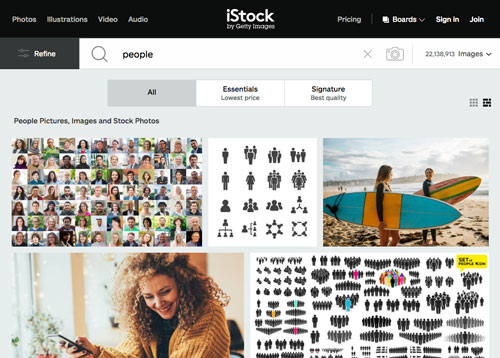
- Photos.com

- Adobe Stock
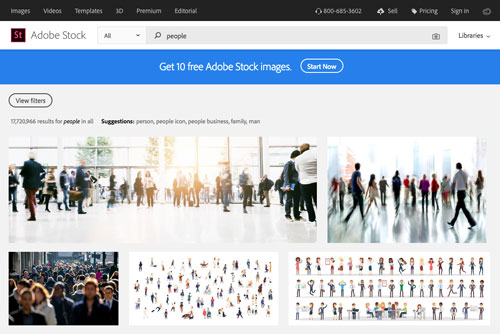
Sharing copyrighted videos
Video-sharing sites like YouTube and Vimeo offer the option to share videos by embedding them. When y'all embed a video, it automatically creates a link back to the identify where it was originally posted. Because the original creator or poster is automatically credited, yous don't have to worry virtually going through whatever extra steps to give credit.
Be aware that many videos on these sites—specially videos of Telly shows and movies—are in violation of copyright police force, and may exist removed from YouTube at any time. If a video is removed from YouTube, it volition also be removed from wherever you lot've embedded it. You should never embed a video that you know is breaking copyright laws.
 An embedded video from YouTube
An embedded video from YouTube
Protecting your intellectual property
Copyright protects the things you create too. You own the original content you postal service on your blog, share on your website, or write in your research paper. If people copy or steal your intellectual property, you have the right to endeavor and stop them.
Guarding your content online
The best way to protect your content is to keep an eye out for it elsewhere. These tips can help you determine if someone else has published your work online, like on a website or weblog.
- Utilise plagiarism search services.
If you choose to publish your work online, these services will analyze your blog or site, and so search for sites with identical content. Copyscape.com is a reputable site with a free plagiarism search. - Set up Google Alerts for excerpts of your work.
Google Alerts is a service you can employ to automatically email you when sites post new data about a person, thing, or result. You can create alerts for things you've written by entering a few sentences from your piece of work in the Search Query field. (Make certain to apply quotation marks.) If that text shows upwardly elsewhere on the Web, you'll receive an email.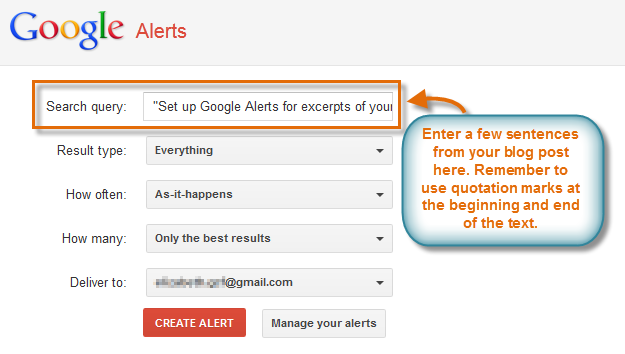 Setting upwards a Google Alert for a weblog post
Setting upwards a Google Alert for a weblog post - Add watermarks to your images.
A watermark is something yous add to an image to identify yourself as its creator—usually a symbol or some text. If you lot choose to share your images online, watermarks make it piece of cake for you lot and other people to recognize images you created. They besides can have the effect of discouraging others from taking your images in the offset identify. You can easily create watermarks in paradigm-editing programs like Picasa and Photoshop.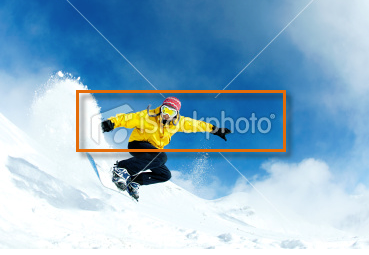 A watermarked epitome
A watermarked epitome
What to practise if yous observe your content on another site
There are two things y'all tin do if you notice your images, text, or other media on someone else'due south website or blog. Outset, you can contact the person who runs the weblog or site that took your content. Well-nigh blogs list a contact e-mail accost, merely if you can't find ane you tin always leave a annotate on the offending post. Inquire firmly just politely to remove your content (or give you lot credit if you don't heed sharing it). This can piece of work, peculiarly in cases when the other person didn't realize whatsoever wrongdoing had occurred.
If contacting the blogger doesn't work, you may want to file a DMCA takedown request. DMCA refers to the Digital Millenium Copyright Deed, a law that's designed to help copyright holders protect their content. Nether this constabulary, if a site steals your original content you lot can complain to that site's service provider. If the service provider finds your complaint valid, information technology will accept down the content.
To learn more about filing a DMCA complaint, read How to Send a DMCA Takedown Discover by Carolyn Eastward. Wright from the blog Black Star Rising.
/en/useinformationcorrectly/how-to-copyright-your-content/content/
Source: https://edu.gcfglobal.org/en/useinformationcorrectly/copyright-and-fair-use/1/
0 Response to "what are the ways to use copyrighted materials lawfully"
Post a Comment